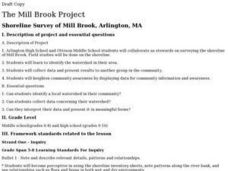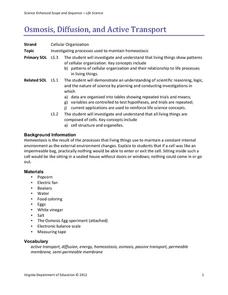Curated OER
Diurnal Temperature Changes and Water Vapor Content
Learners determine how much moisture in the air affects the diurnal temperature range. They investigate to determine the different climatological regimes of both the Southern Plains and the world. and greenhouse gases effect the earth's...
Curated OER
How much Carbon Dioxide is in My Seltzer Water?
Students discover the law of conservation of mass though experimentation. In this chemistry lesson, students experiment with acid - base indicators to determine the presence of carbon dioxide. Students complete the labs with...
Curated OER
Periodic Table of the Elements
Middle schoolers experiment with transition metals. For this transition metals lesson students find the common properties of transition metals and conduct an experiment using one of them. Middle schoolers then answer...
Curated OER
Water in the Texas Coastal Basins
Students, after researching a Texas coastal basin, map and graph the information they collect and then translate it into a short report to be presented to their classmates. They brainstorm unique ways to maintain Texas estuaries as well...
Curated OER
From the Farm to Your Table: Where Does Our Food Come From?
Learners discover where the food they eat comes from. Using maps, they identify the agricultural areas of the United States and the products that are grown in each area. Using the internet, they research how food gets to America from...
Curated OER
Geology Project Notes
In this geology worksheet, students fill in notes using a variety of resources. Students answer questions as it relates to geology, soil erosion, mass movement, and deposition. Students research information about the presented aspects of...
Curated OER
The Wetlands
Fourth graders learn what a wetland is, where they can be found, and what types of plants, animals and characteristic are associated with the wetlands. They also participate in an activity to explore and enhance their knowledge of...
Curated OER
The Study of Urban and Suburban Environments within the Mystic River Watershed
High school students examine their own water-based environments, within the Mystic Watershed. As the learners engage in inquiry-based, hands-on projects, critical thinking skills and problem-solving, the project will lead them to cross...
Curated OER
Sedimentary Rocks
In this sedimentary rocks worksheet, learners conduct an experiment where they observe a shallow dish of water and table salt. Then they determine what causes the salt to leave deposits in the pan. Students also describe sedimentary rock...
Curated OER
Newton's Third Law
In this Newton's Third Law worksheet, students complete a table identifying the action force and reaction force of several examples. Students demonstrate a basic understanding of Newton's Third Law by filling in missing blanks and...
Curated OER
Invertebrate Chordates
In this invertebrate worksheet, students fill in the blank of four statements that focus on the characteristics of invertebrate chordates. Then students will number five statements in the order water flows through a tunicate. Then...
Curated OER
Lesson Six
Pupils investigate the importance of ocean resources and what humans need to do to maintain a healthy ocean. In this oceans lesson plan students participate in an activity after viewing a PowerPoint presentation on the Earth's...
Curated OER
Acids and Bases
Young scholars study acid and bases and how they fall on the pH scale. In this solutions lesson students complete a lob activity using litmus then fill out a data table.
Curated OER
Oxygen Levels and Aquatic Plants and Animals
Students design an experiment to test the effects of a change in the amount of dissolved oxygen of water on aquatic plants and animals. Questions are offered for exploration and experiment design. Results are tabulated and conclusions...
Curated OER
Cycling of Matter and Energy
These twenty various types of questions related to the cycling of matter and energy require students to match each definition in column 1 with the correct vocabulary term from column 2. Then, students explain what is being demonstrated...
Curated OER
Scientific Tools
Students list different uses for common scientific instruments. They identify appropriate instruments to measure length, temperature, and mass. Pupils are given a copy of the "Science Tools" task sheet, students place the correct number...
Virginia Department of Education
Osmosis, Diffusion, and Active Transport
No, it really is okay to play with your food! Emerging scientists manipulate popcorn, eggs, and other household objects as they demonstrate multiple cellular processes. The activity, capable of modifications, is designed to reflect...
Virginia Department of Education
Solar System Model
How many planets can you name? Did you get all 13 in our solar system, including the dwarf planets, or were you surprised when you read there are 13 planets? The lesson helps scholars understand the scale of the universe including the...
Virginia Department of Education
Planet Line-Ups
Should Pluto be considered a planet or a dwarf planet? Scholars research planets in our solar system to understand their similarities and differences. It also includes memory activities related to the order of the planets.
Curated OER
Do You Drink It?
Students explore the aquifer. They create a model of an aquifer and explain how a well works. Students explore the relationship between a well and the water table. They explore the various ways that groundwater becomes contaminated.
Curated OER
Aquifer Model
Learners, after researching and brainstorming about aquifers and locating aquifer maps of Texas, participate in the building of a model of an aquifer complete with a pumping station. They also answer a variety of questions at the...
Curated OER
Thermochemistry
In this thermochemistry worksheet, students indicate whether the given processes are endothermic or exothermic reactions. Students complete the phase change diagram as well as define a given set of vocabulary words. Students calculate...
Curated OER
Rocket Angles
Eighth graders create rockets that be launched at varying angles to determine which angle is best to launch at for the longest distance.
Curated OER
Watersheds and Wetlands
Students discuss the idea of a watershed. They build models of watersheds using paper and observe what happens to their models when it "rains". In addition, they build a second watershed to compare watersheds with wetlands to those without.























